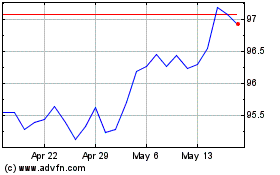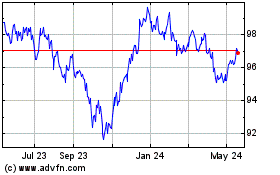Thanks to the immense popularity of ETFs in recent years, there
has been a race to the bottom in the exchange-traded
fund business on the cost front for gaining market share. Many
ETF sponsors have reduced costs to make their funds the cheapest in
a particular category, heating up the competition in the space.
Cost is an important element in selecting funds in the
portfolio, especially when two funds track similar, or even
identical, indexes. Generally, the low-cost product overtakes the
high-cost product and leads in AUM when cost is really the only big
difference between the two funds.
This trend has been especially important for iShares, despite
their solid performance this year as the company has pulled in
about $50 billion in AUM in the first nine months of the year.
Though the firm has among the most in asset inflows, it is
losing share in large liquid funds to low cost ETFs managed by
Vanguard and other low cost providers like Schwab. Still, iShares
occupies about 41% of the U.S. market share with 276 funds in its
total lineup, a figure that is down from 48% reported in 2009.
As a result, iShares recently announced plans to cut the expense
ratio on six core ETFs, making them some of the cheapest offerings
in each of their respective categories. The cut follows the latest
fee reductions by Vanguard and Charles Schwab to boost its assets
inflows amid stiff competition (read: Charles Schwab Slashes Fees
on Entire ETF Lineup).
The products that iShares announced the cuts on are not
unimportant funds either, as iShares has slashed costs on two
important ETFs, Core S&P 500 ETF (IVV) and
Core S&P Total U.S. Stock Market ETF (ISI),
funds that now have expense ratios of just 0.07% per year, making
them some of the cheapest ETFs in any category (ISI’s ticker will
change to ITOT as well).
Though IVV fails in comparison to VOO in terms of expense ratio
by two basis points, the product so far attracted $33.2 billion of
assets compared to $5.7 billion for VOO, suggesting that it could
have a much easier time keeping assets after this
cut.
The other three ETFs – Core S&P Mid-Cap ETF
(IJH), Core S&P Small-Cap ETF (IJR) and
Core Total U.S. Bond Market ETF (AGG) – will now
have expense ratios of 0.15%, 0.16% and 0.08%, respectively. IJH is
the low-cost choice in tracking the S&P MidCap 400 Index,
outstripping IVOO, a Vanguard product, which has an expense ratio
of 0.17%.
Among the three funds tracking the S&P SmallCap 600 Index,
IJR and VIOO will be the cheapest funds in the category. On the
other hand, AGG is the cheapest fund after Charles Schwab’s SCHZ
that tracks the Barclays Capital U.S. Aggregate Bond Index. AGG has
so far managed assets of about $15.9 billion while SCHZ has only
$336.6 million in AUM (read: Ten Biggest U.S. Equity Market
ETFs).
iShares also cut the expense ratio on Core Long-Term
U.S. Bond ETF (GLJ) to 0.12% from 0.20% and decided to
change the tracking index to Barclays US Long Government/Credit
Bond. Furthermore, the new ticker name will be ILTB instead of
GLJ.
The Vanguard product, Long-Term Bond ETF (BLV), tracks the same
index and charges 11 bps in fees per year to investors. We have
seen that the Vanguard product has attracted around $587 million
more assets than iShares’ product owing to lower fees of 1
bps.
While these fee reductions are expected to take a toll on
iShares’ revenue by $35–$40 million, it would boost more cash
inflows for the products. Further, the firm introduced four new
low-fee ETFs to its lineup in order to attract long-term investors
instead of cutting fees on the old funds (read: Who Says iShares
ETFs Aren’t Cheap?).
The new funds - Core MSCI Total International Stock
ETF (IXUS), Core MSCI Emerging Markets
ETF (IEMG), Core MSCI EAFE ETF (IEFA) and
Core Short-Term U.S. Bond ETF (ISTB) – will have
expense ratios of 0.16%, 0.18%, 0.14% and 0.12%, respectively.
These funds are similar to iShares’ four existing ETFs - MSCI
ACWI ex US Index Fund (ACWX), MSCI Emerging Markets Index Fund
(EEM), MSCI EAFE Index Fund (EFA) and Barclays 1-3 Year Treasury
Bond Fund (SHY) that have expense ratios of 0.34%, 0.67%, 0.34% and
0.15%, respectively.
Since these funds have a huge asset base and relatively higher
expense ratios, iShares might have lost $259 million in annual
revenue had it simply cut fees on them instead of introducing the
new products, suggesting that the San Francisco-based firm is
testing a novel strategy of new launches instead of cuts on at
least some of its funds.
This low-cost strategy may also bolster the firm’s competitive
position against its rivals such as Vanguard, Charles Schwab and
State Street in a number of important ETF categories across a
number of asset classes.
This is an interesting plan that has immense ramifications for
the broader ETF world. It suggests that the fight for low-cost
products is intensifying and a number of issuers are coming up with
low fees as cheap funds attract more inflows. The approach helps
investors to build a diversified portfolio with lower cost and
higher returns.
For investors looking for a list of iShares fees changes, we
have highlighted the company’s products below, by AUM, along with
their old and new expense ratios (see more on ETFs in the Zacks ETF
Center):
|
ETF
|
AUM (in millions) as of October
17
|
New Expense Ratio
|
Old Expense Ratio
|
|
IVV
|
$33,237
|
0.07%
|
0.09%
|
|
ISI/ITOT
|
$365
|
0.07%
|
0.20%
|
|
IJH
|
$11,421
|
0.15%
|
0.21%
|
|
IJR
|
$7,925
|
0.16%
|
0.22%
|
|
AGG
|
$15,893
|
0.08%
|
0.20%
|
|
GLJ/ILTB
|
$200
|
0.12%
|
0.20%
|
Want the latest recommendations from Zacks Investment Research?
Today, you can download 7 Best Stocks for the Next 30
Days. Click to get this free report >>
ISHARS-BR AG BD (AGG): ETF Research Reports
(GLJ): ETF Research Reports
ISHARS-SP MID (IJH): ETF Research Reports
ISHARS-SP SC600 (IJR): ETF Research Reports
ISHARS-10+Y GCB (ILTB): ETF Research Reports
(ISI): ETF Research Reports
ISHARS-1500 IDX (ITOT): ETF Research Reports
ISHARS-SP500 (IVV): ETF Research Reports
To read this article on Zacks.com click here.
Zacks Investment Research
Want the latest recommendations from Zacks Investment Research?
Today, you can download 7 Best Stocks for the Next 30 Days. Click
to get this free report
US Aggregate (AMEX:AGG)
Historical Stock Chart
From Jan 2025 to Feb 2025

US Aggregate (AMEX:AGG)
Historical Stock Chart
From Feb 2024 to Feb 2025
